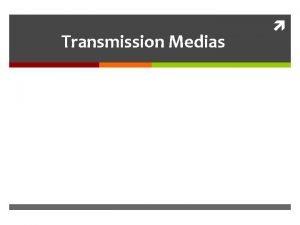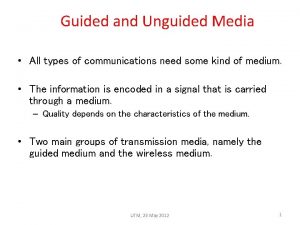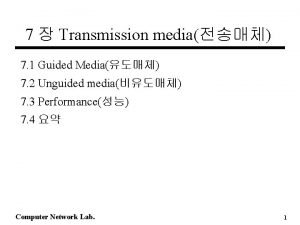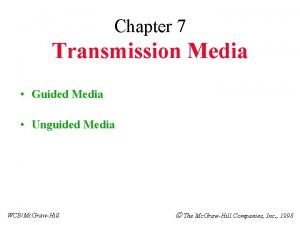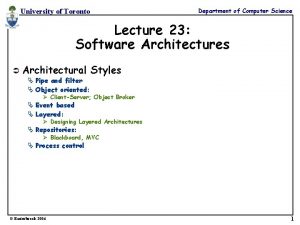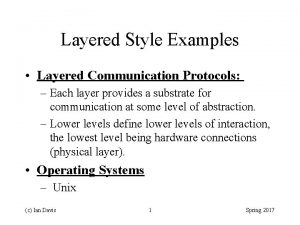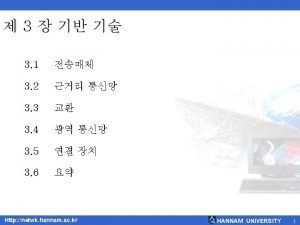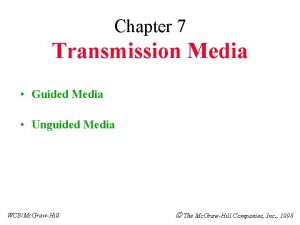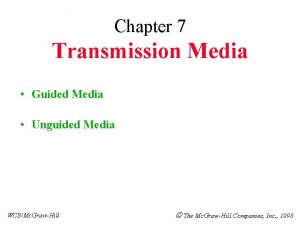Guided Waves in Layered Media Guided Waves in







































- Slides: 39

Guided Waves in Layered Media

Guided Waves in Layered Media Layered media can support confined electromagnetic propagation. These modes of propagation are the so-called guided waves, and the structures that support guided waves are called waveguides.

Symmetric Slab Waveguides • Dielectric slabs are the simplest optical waveguides. • It consists of a thin dielectric layer sandwiched between two semi-infinite bounding media. • The index of refraction of the guiding layer must be greater than those of the surround media.

Symmetric Slab Waveguides • The following equation describes the index profile of a symmetric dielectric waveguide:

Symmetric Slab Waveguides • The propagation of monochromatic radiation along the z axis. Maxwell’s equation can be written in the form

Symmetric Slab Waveguides • For layered dielectric structures that consist of homogeneous and isotropic materials, the wave equation is • The subscript m is the mode number

Symmetric Slab Waveguides • For confined modes, the field amplitude must fall off exponentially outside the waveguide. • Consequently, the quantity (nω/c)^2 -β^2 must be negative for |x| > d/2.

Symmetric Slab Waveguides • For confined modes, the field amplitude must fall off sinusoidally inside the waveguide. • Consequently, the quantity (nω/c)^2 -β^2 must be positive for |x| < d/2.

Guided TE Modes • The electric field amplitude of the guided TE modes can be written in the form

Guided TE Modes • The mode function is taken as

Guided TE Modes • The solutions of TE modes may be divided into two classes: for the first class and for the second class • The solution in the first class have symmetric wavefunctions, whereas those of the second class have antisymmetric wavefunctions.

Guided TE Modes • The propagation constants of the TE modes can be found from a numerical or graphical solution.

Guided TE Modes

Guided TM Modes • The field amplitudes are written

Guided TM Modes • The wavefunction H(x) is

Guided TM Modes • The continuity of Hy and Ez at the two (x=±(1/2)d) interface leads to the eigenvalue equation

Asymmetric Slab Waveguides • The index profile of a asymmetric slab waveguides is as follows • n 2 is greater than n 1 and n 3, assuming n 1<n 3<n 2

Asymmetric Slab Waveguides Typical field distributions corresponding to different values of β

Guided TE Modes • The field component Ey of the TE mode can be written as • The function Em(x) assumes the following forms in each of the three regions

Guided TE Modes • By imposing the continuity requirements , we get • or

Guided TE Modes • The normalization condition is given by • Or equivalently,

Guided TM Modes • The field components are

Guided TM Modes • The wavefunction is

Guided TM Modes

Guided TM Modes • We define the parameter • At long wavelengths, such that No confined mode exists in the waveguide.

Guided TM Modes • As the wavelength decreases such that One solution exists to the mode condition

Guided TM Modes • As the wavelength decreases further such that Two solutions exist to the mode condition

Guided TM Modes • The mth satifies

Surface Plasmons • Confined propagation of electromagnetic radiation can also exist at the interface between two semiinfinite dielectric homogeneous media. • Such electromagnetic surface waves can exist at the interface between two media, provided the dielectric constants of the media are opposite in sign. • Only a single TM mode exist at a given frequency.

Surface Plasmons • A typical example is the interface between air and silver where n 1^2 = 1 and n 3^2 = -16. 40 i 0. 54 at λ = 6328(艾).

Surface Plasmons • For TE modes, by putting t=0 in Eq. (11. 2 -5), we obtain the mode condition for the TE surface waves, p + q =0 Where p and q are the exponential attenuation constants in media 3 and 1. • It can never be satisfied since a confined mode requires p>0 and q>0.

Surface Plasmons • For TM waves, the mode funcion Hy(x) can be written as • The mode condition can be obtained by insisting on the continuity of Ez at the interface x = 0 of from Eq. (11. 2 -11)

Surface Plasmons • The propagation constant β is given by • A confined propagation mode must have a real propagation constant, since <0,

Surface Plasmons • The attenuation constants p and q are given

Surface Plasmons • The electric field components are given

Surface Plasmons • Surface wave propagation at the interface between a metal and a dielectric medium suffers ohmic losses. The propagation therefore attenuates in the z direction. This corresponding to a complex propagation constants β • Where α is the power attenuation coefficient.

Surface Plasmons • In the case of a dielectric-metal interface, is a real positive number and is a complex number (n – iκ)^2, and the propagation constant of the surface wave is given

Surface Plasmons • In terms of the dielectric constants • The propagation and attenuation constants can be written as

Surface Plasmons • The attenuation coefficient can also be obtained from the ohmic loss calculation and can be written as • σ is the conductivity
 Mechanical and electromagnetic waves
Mechanical and electromagnetic waves What is a semiconductor used for
What is a semiconductor used for Seismic waves
Seismic waves Transfer of energy when a wave disappears into a surface
Transfer of energy when a wave disappears into a surface What are constructive waves
What are constructive waves Difference between matter waves and electromagnetic waves
Difference between matter waves and electromagnetic waves Lowest point of a wave
Lowest point of a wave Seismic waves are mechanical waves
Seismic waves are mechanical waves Characteristics of a longitudinal wave
Characteristics of a longitudinal wave Mechanical vs electromagnetic
Mechanical vs electromagnetic Transverse wave vs longitudinal wave
Transverse wave vs longitudinal wave Compare and contrast p waves and s waves using venn diagram
Compare and contrast p waves and s waves using venn diagram Whats a reflected sound wave
Whats a reflected sound wave Mechanical and electromagnetic waves similarities
Mechanical and electromagnetic waves similarities Examples of mechanical waves
Examples of mechanical waves Guided media
Guided media Compare guided and unguided media
Compare guided and unguided media Sport and the mass media guided reading
Sport and the mass media guided reading Transmission media
Transmission media Wcb
Wcb Layered curriculum
Layered curriculum Layered curriculum
Layered curriculum Layered task
Layered task What is layered structure of operating system
What is layered structure of operating system Layered operating system
Layered operating system Software engineering a layered technology
Software engineering a layered technology Double-layered pleural membrane
Double-layered pleural membrane Device management system calls
Device management system calls Layered structure in os
Layered structure in os Layered architecture
Layered architecture Layered curriculum template
Layered curriculum template Causal layered analysis
Causal layered analysis Horseshoe section hair
Horseshoe section hair Layered structure in os
Layered structure in os A robust layered control system for a mobile robot
A robust layered control system for a mobile robot Generic view of software engineering
Generic view of software engineering Layered tasks
Layered tasks Definition of operating system
Definition of operating system Layered architecture
Layered architecture Layered architecture of jini system
Layered architecture of jini system















